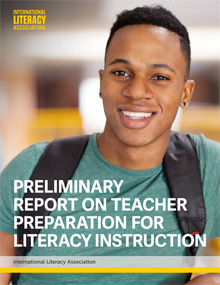 The International Literacy Association issued its Preliminary Report on Teacher Preparation for Literacy Instruction Tuesday, the first of a two-part report by its Teacher Preparation Task Force, reviewing U.S literacy teacher preparation and how state departments of education differ in their requirements. The preliminary report uncovered inconsistent standards and criteria for preparing teachers on how to teach literacy.
The International Literacy Association issued its Preliminary Report on Teacher Preparation for Literacy Instruction Tuesday, the first of a two-part report by its Teacher Preparation Task Force, reviewing U.S literacy teacher preparation and how state departments of education differ in their requirements. The preliminary report uncovered inconsistent standards and criteria for preparing teachers on how to teach literacy.
“While there are limitations to this data and further review is underway, our initial findings show that few states require coursework related to preparation to teach literacy,” said Deanna Birdyshaw, cochair of the ILA Teacher Preparation Task Force. “Further investigation of both state and preservice teacher preparation programs is necessary. The data contained here reflect the first phase of our study of what states’ requirements are for preservice teachers in terms of developing their skills as literacy instructors.”
The 13-member task force is cochaired by Elizabeth Swaggerty, associate professor of Reading Education at East Carolina University, in addition to Birdyshaw, lecturer at University of Michigan, and includes leading literacy experts from across the United States.
The task force used a two-part procedure to inform this preliminary report. The first part included compiling information about requirements for teacher preparation in literacy from 50 state education department websites between July and October 2014. The task force then interviewed state education department officials from 23 states to confirm the data collected and to increase understanding of how literacy instruction was addressed in the certification guidelines.
The second-year goal is to interview Teacher Education Programs officials, administrators, and professors in all 50 states to determine how they are integrating the guidelines.
Implications of findings
“Our primary takeaway is that all stakeholders need to be involved in the conversation about how to improve preparation of preservice teachers to design and implement instruction that increases the literacy learning of children in kindergarten through grade 12,” Swaggerty said. “We hope this initial report is a starting point for that conversation.”
Given the importance that state education standards and assessments play in the review of Teacher Education Programs, analysis of the data suggests:
- Research that investigates preservice program features that prepare candidates to develop students’ literacy across all grades and in all disciplines should be conducted. This research should be shared with all stakeholders, particularly state departments and teacher preparation programs.
- Collaboration among all educational stakeholders, particularly state education departments, teacher preparation programs, and K–12 educators, is necessary to improve the preparation of candidates to teach literacy. State guidelines for preservice teacher preparation should make explicit reference to what candidates should know and be able to do in relation to literacy instruction.
- All preservice teachers should be required to participate in activities during their practica that develop their ability to design literacy instruction and monitor literacy growth.
In considering the findings, the task force recognized three primary limitations to the research.
- This is a preliminary report with the second phase ongoing.
- Teacher education programs are in transition, with state education department officials from 15 of the 23 states interviewed stating that changes were being made to teacher certification requirements in the coming year.
- State education officials interviewed were knowledgeable about the teaching requirements, but not necessarily experts in the areas related specifically to teaching literacy.
“Today’s teachers must be well prepared to help students acquire the literacy skills they will need to learn, work, and live in a complex world,” said Dan Mangan, ILA’s Director of Public Affairs. “The preliminary work of this task force has helped us to better understand the landscape of state-level standards and criteria for teacher preparation for literacy instruction through a research-validated framework. We look forward to insights from the second phase of the task force to determine how best to move ahead to ensure the more than 250,000 new teachers entering the work force annually are prepared.”
To read the full text of the report, visit http://literacyworldwide.org/prelimprepreport.